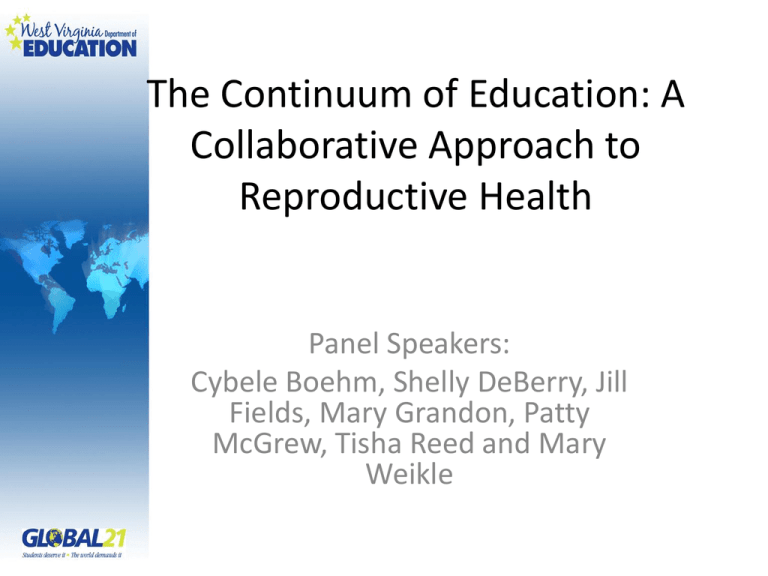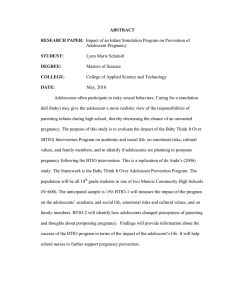The Continuum of Education: A Collaborative Approach to Reproductive Health
advertisement

The Continuum of Education: A Collaborative Approach to Reproductive Health Panel Speakers: Cybele Boehm, Shelly DeBerry, Jill Fields, Mary Grandon, Patty McGrew, Tisha Reed and Mary Weikle Objectives : • Participants will acquire knowledge and resources on the current options and resources available to address teen reproductive health. • Participants will understand the importance and effectiveness of a collaborative approach to address adolescent reproductive health education and services. • Participants will learn from one SBHC’s model how reproductive health issues are addressed, what family planning services are available and the collaboration that exists. West Virginia Department of Education Office of Healthy Schools Cybele Boehm CSPHP/HIV/AIDS Program Coordinator Mary Weikle Health and PE Coordinator cboehm@access.k12.wv.us mweikle@access.k12.wv.us 304-558-8830 304-624-6554 ext. 259 Youth Risk Behavior Survey (YRBS) 2009 Percentage of WV high school students who ever had sexual intercourse is 54.1 (compared to 46% nationwide) Among WV students who were sexually active, the percentage who used a condom during last sexual intercourse is 54.4 in 2009 (compared to 61.1% nationwide). Among WV students, 15.5% reported having had sex with 4+ people in their life (compared to 13.8% nationwide). Youth Risk Behavior Survey (YRBS) 2009 Percentage of WV high school students who did not use birth control pill before last intercourse is 76.9. Percentage of students who had ever been taught in school about AIDS or HIV infection is 82.8. YRBS Trend data posted at http://wvde.state.wv.us/healthyschools/documents/2009WVH TrendReport_000.pdf. In 2008, CDC-Division of STD Prevention stated that 1 in 4 adolescent females has an STD. • In a recent CDC report, West Virginia was the only state with an increase in teen birth rate in the past two years. WV State Teen Pregnancy Plan • Existing Resources: – CSPHP created in 2009 – Regional Network – Local County Wellness Councils • Proposed Strategic Efforts – Collaboration between WVDE and WVDHHR – Top Down support (curricula, resources, linkages, in-school collaboration) Policy 2520.5 Health Content Standards and Objectives (*Under Public Comment!) A major focus has been given to what the Center for Disease Control recognizes as adolescent risk behaviors (tobacco use, dietary patterns contributing to disease, sedentary lifestyle, sexual behaviors that result in HIV infection/other STDs and unintended pregnancy, alcohol and other drug use, and behaviors that result in intentional and unintentional injury). Policy 2520.5 Content Standards Content Standards are the broad descriptions of what all students must know and be able to do at the conclusion of the instructional sequence. 1: Health Promotion and Disease Prevention 2: Culture, Media and Technology 3: Health Information and Services 4: Communication 5: Decision-Making 6: Goal Setting 7: Health Behaviors 8: Advocacy • Objectives are incremental steps toward accomplishment of content standards. • Objectives are listed by grade level and are organized around the content standards. Objectives build across grade levels as students advance in their knowledge and skills. • The instructional objectives guide instructional planning and provide a basis for determining appropriate assessments, instructional strategies and resources. 6th Grade • HE.6.1.03 discuss and examine strategies for the prevention of injuries (e.g., fractures, laceration, head trauma), communicable diseases (STD’s, HIV and AIDS), and other health problems. • HE.6.7.01 differentiate between safe and risky behaviors in relationships (e.g., abuse, date rape, peer pressure, sexual activity). • HE.6.7.02 contrast the differences between safe and risky behaviors for preventing pregnancy and STDs (e.g., abstinence, birth control, drug use). 7th Grade • HE.7.1.03 Describe the anatomy and functions of the reproductive system. • HE.7.1.04 Identify general symptoms and potentially long– term health consequences of STD’s. • HE.7.7.01 Discuss risky or harmful behaviors in relationships (e.g., abuse, date rape, sexual activity). • HE.7.7.02 analyze the differences between safe and risky behaviors including methods for preventing pregnancy and STDs (e.g., abstinence, birth control, disease control). 8th Grade • HE.8.1.03 Label and explain the functions of the bodies systems (e.g. circulatory, skeletal, reproductive, digestive). • HE.8.1.04 Determine the risk factors that lead to teen pregnancy, HIV/AIDS and other STD’s. • HE.8.4.04 Compare and contrast various refusal and negotiation skills to avoid or reduce risky and harmful health behaviors (e.g. pregnancy, drunk driving, STDs, dating violence, harassment, ATOD). • HE.8.7.02 Contrast the differences between safe and risky behaviors including methods for preventing pregnancy and STDs (e.g., abstinence, birth control). High School • HE.HS.1.04 Differentiate between the causes of communicable (e.g., STDs, HIV/AIDS, bacterial/viral infections) and noncommunicable (e.g., heredity, lifestyle, environment) diseases. • HE.HS.1.05 Identify and apply skills to prevent communicable (e.g., STDs, HIV/AIDS, bacterial/viral infections) and noncommunicable (e.g., heredity, lifestyle, environment) diseases. • HE.HS.4.01 utilize skills for effective communication in discussion concerning ATOD, nutrition, sexuality, and relationships with peers, family and others. High School • HE.HS.5.02 Identify and discuss health concerns that require collaborative decision-making (e.g., sexuality, STDs, HIV/AIDS transmission/prevention, refusal skills). • HE.HS.5.03 Analyze the effects of potentially harmful decisions that impact health and the effect these decisions have on their family, community and self (ATOD use, STD transmission, pregnancy prevention, teen parenting). • HE.HS.7.03 List examples and explain short and long term impacts of health decisions (e.g., smoking, good diet, wearing seat belts) on the individual, family and community (e.g., lung cancer, heart disease, STDs). HIV/AIDS EDUCATION 126CSR51 Instruction on the principle modes by which communicable diseases, including, but not limited to, human immunodeficiency virus (HIV)/acquired immunodeficiency syndrome (AIDS) are prevented, spread and transmitted shall be taught to students as outlined in 126CSR44E West Virginia Board of Education Policy 2520.5, Health Content Standards and Objectives. An opportunity shall be afforded to the parent or guardian of a child subject to instruction in the prevention, transmission and spread of HIV/AIDS and other sexually transmitted diseases to examine the course curriculum requirements and materials to be used in such instruction. The parent or guardian may exempt such child from participation in such instruction by giving notice to that effect in writing to the school principal as set forth in W. Va. Code §18-2-9. Shelly DeBerry West Virginia Department of Education Office of School Improvement Student Success Advocate sdeberry@access.k12.wv.us 304-558-3199 “Every school-day in America, 171 school buses loaded with children leave school never to return. That is our daily dropout rate.” (National Center for Education Statistics, 2004. Dropout Rates in the United States: 2001) Approximately, 7000 students are expected to dropout of school in West Virginia this year. Education Week Diplomas Count 2010 19 How does WV Rate? • In 2006, West Virginia had a teen pregnancy rate of 44.9 per 1,000 teenage girls, which placed the state 16th in the nation. • Birth rates for young teenagers aged 15–17 declined in 31 states during 2007–2009 • Birth rates increased significantly for only one state from 2007 through 2009, West Virginia, by 17 percent. NCHS Data Brief ■ No. 58 ■ February 2011 What’s the Cost? • Teen pregnancies cost the nation about $9.1 billion a year, according to the CDC. • Other Cost of Dropouts Students Who Earn More Learn More Long Term Effects Over the course of his or her lifetime, a high school dropout earns, on average, about $260,000 less than a high school graduate. 23 Increasing the graduation rate and college matriculation of male students in the United States by just 5 percent could lead to combined savings and revenue of almost $8 billion each year by reducing crime-related costs. 24 If the United States‘ likely dropouts from the Class of 2006 had graduated, the nation could have saved more than $17 billion in Medicaid and expenditures for uninsured health care over the course of those young people‘s lifetimes. 25 Correlations with Dropping out of School 70 % of young women who gave birth within 4 years of starting high school also left before graduating. They represent 32.8 % of dropouts ands 18.7% of all student enrolled in school. 70% of students who had substantiated case of abuse and neglect during the high school years, who had a foster care placement, or who had given birth within four years of starting high school, dropped out in Philadelphia. (Neild Y Balfanz, 2006) Teen Pregnancy Teen girls in the bottom 20% of basic reading and math skills are five times more likely to become mothers over a two-year high school period than teen girls in the top 20% Male and female students with low academic achievement are twice as likely to become parents by their senior year of high school compared to students with high academic achievement. National Dropout Prevention Center/Network 27 (Alliance for Excellent Education, 2003) Children of Teenagers • More likely to repeat grades • Do worse on standardized tests • Less likely to complete high school (Reitzi, 2005) National Dropout Prevention Center/Network 28 APPI Contact Information Northern: Eastern: Vacant Cynthia Hinkle 304-257-4922 cindy.r.hinkle@wv.gov Central: Deena Ellison 304-558-5388 deena.s.ellison@wv.gov Southern: Brandi Seabolt 304-250-6548 brandi.l.seabolt@wv.gov Director: Vacant WV DEPARTMENT OF HEALTH AND HUMAN RESOURCES OFFICE OF MATERNAL, CHILD AND FAMILY HEALTH FAMILY PLANNING PROGRAM ADOLESCENT PREGNANCY PREVENTION INITIATIVE Vacant Adolescent Pregnancy Prevention Initiative 350 Capitol Street, Room 427 Charleston, WV 25301-3714 (304) 558-5388 or 1-800-642-8522 Fax: 558-7164 tisha.g.reed@wv.gov Northern Region Vacant Adolescent Pregnancy Prevention 9083 Middleton Mall White Hall, WV 26554 (304) 368-4420 x 79328 Fax: (304) 368-4191 HANCOCK BROOKE OHIO MARSHALL MONONG ALIA WETZEL MORGAN MARION PRESTON TYLER Central Region Deena Ellison Adolescent Pregnancy Prevention 350 Capitol Street, Room 427 Charleston, WV 25301-2714 (304) 558-5388 or 1-800-642-8522 FAX: (304) 558-7164 deena.s.ellison@wv.gov HAMPSHIRE PLEASANTS DODD- HARRISON RIDGE WOOD RITCHIE BARBOUR TUCKER BERKELE Y JEFFERSON GRANT HARDY WIRT LEWIS GILMER JACKSON UPSHUR CALHOUN RANDOLPH ROANE MASON BRAXTON PENDLETON WEBSTER PUTNAM CLAY CABELL KANAWHA NICHOLAS POCAHONTA S LINCOLN WAYNE BOONE FAYETTE GREENBRIER MINGO LOGAN RALEIGH WYOMING SUMME RS Southern Region Brandi Seabolt Adolescent Pregnancy Prevention Post Office Box 1069 Beckley, WV 25802-1069 (304) 250-6548 Fax# (304) 250-6560 brandi.l.seabolt@wv.gov MINERAL TAYLOR ME RCER MCDOWELL MONROE Eastern Panhandle Cindy Hinkle Grant County Health Department PO Box 608, Hospital Drive Petersburg, WV 26847 (304) (304) 257-4922 Fax# (304) 257-2422 cindy.r.hinkle@wv.gov WVDHHR/BPH/OMCFH/DPWH/FPP/APPI/June 2011 West Virginia Department of Health and Human Resources Bureau For Public Health Office of Maternal, Child and Family Health Family Planning Program Adolescent Pregnancy Prevention Initiative 1-800-642-8522 wvdhhr.org/appi WV APPI influences and supports teens as they explore and determine responsible sexual and reproductive options for their future. Adolescent Pregnancy Prevention Initiative APPI conducts hundreds of classroom presentations during each school year. • Nearly 20,000 students participated in APPI activities last year. • 100,000 items from prevention literature to videos, public service announcements and even brochures on sexually transmitted infections are distributed each year by APPI Specialists. Available Curricula • Wise Guys: Male Responsibility • Reducing the Risk: Building Skills to Prevent Pregnancy, STD and HIV • COMING SOON: SiHLE and Making Proud Choices! West Virginia Department of Health and Human Resources Bureau For Public Health Office of Maternal, Child and Family Health Division of Infant, Child and Adolescent Health Adolescent Health Initiative 1-800-642-8522 wvdhhr.org/ahi Patty McGrew, Director Patty.F.McGrew@wv.gov The underlying philosophy of the Adolescent Health Initiative is holistic, preventive, and positive focusing on the development of assets and competencies in youth as the best means for fostering health and well-being and for avoiding negative choices and outcomes. Adolescent Health Initiative • Adolescent Health Coordinators • • • • Community-Based Funded by Temporary Assistance for Needy Families (TANF) Primary focus is positive youth development Centered on Search Institute’s 40 Developmental Assets • Adolescent Health Educators • • • • School-Based Funded by Title V State Abstinence Education Grant Program Primary focus is teen pregnancy prevention Centered on “Promoting Health Among Teens” curriculum Adolescent Health Coordinators • The Adolescent Health Coordinators (AHCs) work to educate communities about the 40 Developmental Assets providing information, resources and technical assistance • AHCs actively collaborate with local partners to link adolescents in need of preventive health care • AHCs work with local groups to design programs which respect the values and concerns of the community. • Free resource materials Adolescent Health Educators • The Adolescent Health Educators (AHEs) provide medically accurate sexual educational classes and parent seminars • The AHEs work with local groups to design programs which respect the values and concerns of the community. • Free resource materials • Make referrals for contraceptive services and/or STI testing Adolescent Health Educators HANCOC K Wetzel County Commission BROOKE OHIO MARSHALL Regeneration, Inc. MONONGALIA WETZEL Women’s Care Center PRESTON TYLE R PLEASANT S HAMPSHIRE MINERAL DODD HARRISON -RIDGE WOOD RITCHIE MASO N BERKELE Y JEFFERSO N TUCKER GRANT HARDY LEWI S GILME R JACKSON TAYLOR BARBOUR WIRT UPSHUR CALHOUN RANDOLP H BRAXTON ROAN E PENDLETON WEBSTER PUTNAM CLAY CABELL Rainelle Medical Center NICHOLA S KANAWHA WAYNE MORGAN MARION POCAHONTAS LINCOL N BOON E FAYETTE GREENBRIER MINGO LOGAN RALEIGH WYOMING SUMMERS MONROE MERCER Mission WV-THINK (TPP) MCDOWEL LL AHI State Office Community Action of SE WV Region 6 Hancock Dara Pond Marshall County Family Resource Network Adolescent Health Coordinators Brooke Ohio Region 5 Region 7 Marshall Stella Moon RESA V Wetzel Pleasants Tyler 50 I77 Barbour Grant 33 Upshur Region 8 Randolph Braxton Pendleton 35 Cabell Putnam Webster I79 Clay I64 Nicholas Kanawha Wayne Lincoln Boone I77 Mingo Logan Pocahontas 19 Fayette Greenbrier 119 Cathy Davis Valley Health Systems, Inc. Tucker Raleigh Wyoming I77 Christine Merritt Pendleton Community Care Region 4 Nonie Roberts New River Health Association I64 Sum mers Mercer McDowell Jeff erson Hardy Lewis I79 Roane Mineral Hampshire ridge Cal - Gilmer houn I81 Morgan Berkeley Preston I79 Taylor Dodd - Harrison Ritchie Jackson Mason I68 Marion Wirt Region 3 Region 2 Idress Gooden RESA VII Monongalia Wood Margo Friend United Way of Central WV I70 Monroe Region 1 Celi Van Dyke RESA I Denotes lead agency location AHC Contact Information Celi Van Dyke RESA I 304-256-4712, Ext 1120 mvandyke@accesss.k12.wv.us Stella Moon RESA V 304-485-6513, Ext 120 smoon@access.k12.wv.us Cathy Davis Valley Health 304-617-8890 cdavis@valleyhealth.org Dara Pond Marshall FRN 304-845-3300 ahicoordinator@comcast.net Margo Friend United Way 304-340-3622 ahiuwcwv@yahoo.com Idress Gooden RESA VII 304-624-6554, Ext. 245 igooden@access.k12.wv.us Nonie Roberts New River 304-877-6342 nonieroberts@suddenlink.net Christine Merritt Pendleton Community Care 304-358-2531 cmerritt@pcc-nfc.org AHE Contact Information Darla Thomas Rainelle Medical Center 304-438-6188, Ext 1082 dthomas@rmchealth.org Theresa Hoskins Wetzel County Commission 304-771-8533 wcfrn@yahoo.com Brad Riser Regeneration, Inc. 304-643-4187 ritprojectchat@yahoo.com Janet Kimes Women’s Care Center 304-485-7122 wcc@wirefire.com Jim Pettus CASE WV 304-325-2441 jpettus@casewv.org SBHC Jill Fields, P.A.-C 304-949-3591 jfields@cchcwv.com Mary Grandon, P.A. Family Planning in a SBHC WHAT??? Condoms Oral contraceptive pills Contraceptive patches Nuvaring Depo-Provera Family Planning in a SBHC “LARCs”—long acting reversible contraceptives: Mirena IUC Paragard IUC Implanon Family Planning in a SBHC STI Prevention Screening Treatment LOTS OF COUNSELING!!!!! Family Planning in a SBHC WHO??????? “EVERY PATIENT” Don’t forget the guys!!!! Risk assessments Encourage “coached” autonomy Encourage healthy relationship-building with peers and parents/guardians Encourage connectedness between adolescents and caregivers Family Planning in a SBHC HOW?????????????????? VERY CAREFULLY!!!! Assess need Assess ability to meet need Assess support



